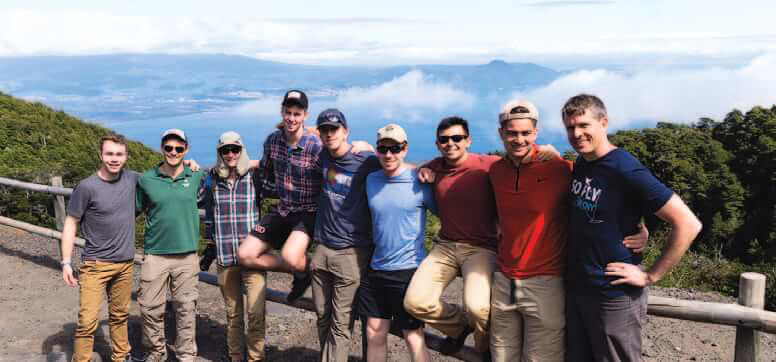DRONE JOURNEY
By Commander Josh Dittmar ’94, USN

Reading about a place is one thing, but experiencing it first-hand imprints on the mind, the sights, the smells, the tastes, the sounds and the feel of the culture. Eight midshipmen and I had that type of opportunity to experience Chile over Spring Break 2019 during a Language, Regional Expertise and Cultural Awareness (LREC) trip made possible through private support of the Academy’s International Programs Office.
“Drones and Defense” explored Chile’s use of drone technologies in humanitarian and disaster response scenarios and their potential defense capabilities and used drones to capture images and videos of the country’s diverse beauty.
The trip began in the capital, Santiago, where the team met with two drone technology organizations: one working to help public servants during disaster relief scenarios and one pioneering the use of Artificial Intelligence to analyze drone data and maximize the utility of the data provided by drones. One representative noted that “Chile es un laboratorio de desastre natural … Chile is a natural disaster laboratory,” experiencing large wildfires, earthquakes, hurricanes, landslides and volcanic eruptions in recent history. The midshipmen learned about the challenges and advantages of incorporating drones into search and rescue scenarios and disaster response events and as well as funding and sharing of basic research worldwide to remain abreast of scientific and technical advances.
After two days we headed to Valparaiso, a maritime city where the team visited the Chilean Naval Academy. German-trained, the Chilean cadets have some interesting traditions including goose-stepping in parades. Some cadets had previously spent a semester at Navy and were already good friends with members of the team. The Chileans spoke with pride of their naval history, especially of Arturo Prat, a naval hero in the War of the Pacific. A demonstration of the Chilean ship simulator proved to be quite similar to USNA’s ship simulators, with the exception of the high speeds favored by the Americans. The last stop on the tour was the dorms, where midshipmen learned that all but the seniors are required to roust themselves from bed at 0600 daily and plunge through a gauntlet of cold water showers.
Following a visit to talk drones with a professor at the local technical university, we discovered the magnetic sand dunes of Concon before heading back to Santiago for a flight south to the Lakes Region. Arriving in Puerto Varas and Chiloe, the northernmost bounds of Patagonia, the team had great weather and incredible locations to fly drones, including the shores of Chile’s Lake Llanquihue, the slopes of the active Volcan Osorno, and the rocky Pacific beaches near Cucao, near Chiloe’s famous wooden stilt houses and around brightly painted churches in Castro.
The midshipmen bonded as a team and learned many things about the culture and each other. Since not all members spoke fluent Spanish, some had to learn to be comfortable with their language missteps. Cut off from the west by the Pacific, the East by the Andes, the South by Patagonia and the North by Atacama, Chileans speak less formal Spanish than in many other Latin American countries, with many Chilenismos (slang words) that have crept into everyday speech. “I was surprised that their Spanish was so different,” Midshipman Alejandro Bello ’21, a native Spanish speaker, observed.
Interactions with locals provided the team with an excellent way to improve their Spanish and learn more of the Chilean culture, trying foods such as octopus in its own ink, learning about wine, observing families in the park and dancing salsa.
The experience ended with a return flight and overnight in Santiago. The smells of hot empanadas sounds of Latin beats and sights of brightly colored towns and majestic landscapes had faded, but the spark had already been lit in the imagination and hearts of the team.
Aerospace Engineering Instructor CDR Josh Dittmar ’94, USN, also led a Drone LREC in Norway in summer 2018.
Source: Shipmate: April-May 2019